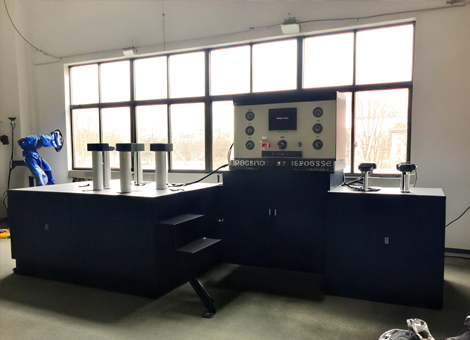Jun 25, 2025
Butterfly valves are widely used in various industrial applications due to their simple structure, compact design, and efficient flow control capabilities. To ensure their performance, reliability, and safety under different working conditions, butterfly valves must undergo a series of strict testing procedures. These tests verify their ability to withstand pressure, prevent leaks, and function properly within the designed specifications. Among the essential testing methods are hydrostatic testing and gas valve pressure testing, typically performed using a hydro test bench or a specially designed valve pressure test system.

Hydrostatic Testing on Butterfly Valves
Hydrostatic testing, often referred to as hydro test bench testing, is a key procedure for evaluating the strength and sealing performance of butterfly valves. During this test, the valve is filled with water and subjected to a specified pressure that is usually higher than its normal working pressure. The goal is to confirm that the valve body, seals, and seats can withstand the pressure without deforming or leaking.
The hydrostatic testing process typically includes two parts:
Shell Test:
In this step, the entire valve body is pressurized while the valve is partially open or fully closed, depending on the testing standard. The pressure is maintained for a defined period while the operator carefully observes for any visible leakage from the valve body or sealing areas.
Seat Test:
For the seat test, the valve is fully closed, and pressure is applied to one side of the disc. The test checks whether the valve seat can prevent leakage under pressure. After one side is tested, the process is repeated on the opposite side to ensure sealing performance in both directions.
Hydrostatic testing on a hydro test bench provides clear and reliable verification of the valve’s pressure resistance and sealing capability. This method is crucial to ensure that the butterfly valve can safely operate in pipelines carrying liquids under high pressure.
Gas Valve Pressure Testing
Apart from hydrostatic testing, gas valve pressure test procedures are also commonly performed, especially when the valves are intended for gas service or when the application requires a gas-tight seal. Unlike hydrostatic testing, which uses water as the testing medium, gas valve pressure testing uses air, nitrogen, or other inert gases to pressurize the valve.
Gas pressure testing focuses on identifying even the small leaks that might not be detected during a hydrostatic test. The procedure typically includes:
Applying the specified gas pressure to the valve.
Using soap solution, electronic sniffers, or mass spectrometers to detect potential gas leaks around the valve body, stem, and seat areas.
Monitoring pressure gauges over a holding period to ensure no pressure drop, which would indicate a leak.
Gas valve pressure testing is particularly sensitive and often used for valves that will handle gases in their real-world applications, such as natural gas pipelines, air systems, or chemical processes involving gaseous substances.
The Role of the Hydro Test Bench in Valve Testing
The hydro test bench plays a significant role in both hydrostatic and gas valve pressure testing. It is a specialized piece of equipment that provides controlled and safe pressure application, accurate measurement, and convenient handling of valves during the testing process.
Hydro test benches are typically equipped with:
Pressure pumps capable of generating the required test pressures.
Clamping mechanisms to securely hold butterfly valves of various sizes.
Digital or analog gauges for pressure monitoring.
Safety relief systems to prevent overpressure situations.
For gas valve pressure tests, some hydro test benches can be adapted to handle gas testing by incorporating gas supply systems and specialized leak detection tools.
By using a hydro test bench, operators can efficiently carry out both water and gas-based pressure tests in a controlled environment. This equipment ensures that butterfly valves meet the required performance standards before being installed in critical systems.
Common testing procedures for butterfly valves, including hydrostatic testing and gas valve pressure test processes, are essential to validate valve quality, sealing performance, and pressure resistance. Both types of tests provide valuable insights into the valve’s ability to function safely in real-world applications. The hydro test bench serves as a vital tool for carrying out these tests accurately and efficiently, helping manufacturers and users maintain confidence in the safety and functionality of butterfly valves used across industries.